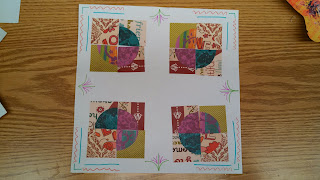This project was a lot of fun and incorporated a hidden picture which is something I have only ever seen previously, and this allowed me to create one of my own for a great new project. For this project, we drew a simple picture of a jungle animal using light blue colored pencil and then hid the picture using warm colors to offset the picture we drew.
Instructions:
1. We began this lesson by making 'magic ruby red glasses'. These were glasses traced onto construction paper and cut out, then we glued red cellophane to the glasses to create the lenses. These were set aside to be used later in the lesson.
2. Students practiced drawing several objects upside down- beginning with a simple pattern then moving on to more complicated drawings. The professor explained that this technique of drawing upside down helps to stimulate our brain into completing a task in a creative new way, and to prepare our minds for the 'trick' of hiding the drawings later, only to have them be revealed using the special red glasses.
3. We then chose an animal from a packet of jungle animals. I chose to draw a little elephant with a few trees in the background. For this drawing, we were able to flip the picture the correct way to draw instead of continuing to draw the more complicated picture upside down. The picture was lightly drawn with a light blue colored pencil onto construction paper.
4. Once our picture was drawn in blue, we began to layer the picture with warm colors- yellows, reds, oranges to create patterns and layers. The layers that are added help hide the picture that was drawn, and helped draw attention away from the light blue marks on the page through the larger, darker objects I had drawn. From time to time, it was helpful to use the red glasses to visualize where more warm colors needed to be added, and if there had been enough added.
5. A frame was added to the project, and then we were really able to appreciate the effect of the colors we used to create a hidden picture. In wearing the glasses, our eyes filter out the layers that were added on top of the blue picture, and we were able to see the color in blue clearly. To finish the project, we added three clues to help other students guess what our animal and picture was of.
Extension Activity:
I think this project is a great way to incorporate many different subject matters. Obviously, this would be a great project to be completed during art time. One of the best things about this particular project is that any and everything can be drawn in and then layered. I can think of using this for many subject matters, such as drawing words or sentences for language arts, pictures for science, countries and continents for social studies, and math concepts for mathematics. This is also a great way for students to spend free time when assignments are completed, and can be used over and over- which allows students for many fun and creative pictures to view.





















.JPG)






